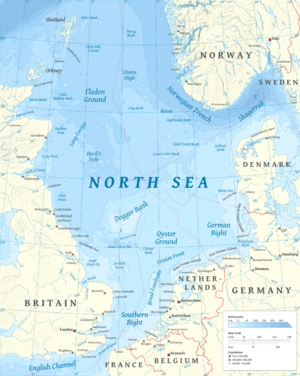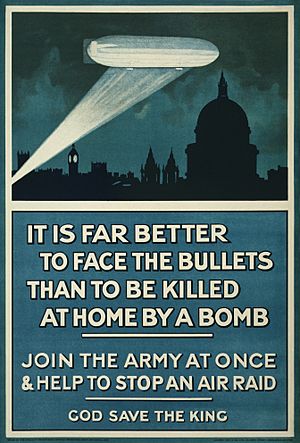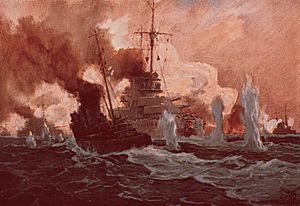Bombardment of Yarmouth and Lowestoft facts for kids
Quick facts for kids Bombardment of Great Yarmouth and Lowestoft |
|||||||
|---|---|---|---|---|---|---|---|
| Part of the First World War | |||||||
 North Sea |
|||||||
|
|||||||
| Belligerents | |||||||
| Commanders and leaders | |||||||
| Casualties and losses | |||||||
| 25 killed 19 wounded 2 light cruisers damaged 1 submarine sunk 200 houses shelled |
11 killed 1 cruiser damaged 1 submarine sunk 1 submarine captured |
||||||
The Bombardment of Yarmouth and Lowestoft, also called the Lowestoft Raid, was a naval battle during the First World War. It happened in the North Sea between the navies of Germany and the British.
Germany sent a group of powerful ships called battlecruisers, along with smaller cruisers and destroyers. Their leader was Rear Admiral Friedrich Boedicker. Their mission was to attack the coastal towns of Yarmouth and Lowestoft. These towns were important for the military. But the main goal was to trick British ships into coming out. Then, the German battlecruisers or the main German fleet could attack them.
The battle didn't have a clear winner. The British ships nearby were too few to fight the German battlecruisers. They mostly stayed away. The German ships left before the larger British fleets could arrive.
Contents
Why it Happened
In early 1916, Admiral Reinhard Scheer became the new leader of the German High Seas Fleet. He started a new plan against the Royal Navy, Britain's navy. His idea was to make quick attacks on British waters. This would hopefully trick British ships into coming out to fight. The Germans wanted to fight under conditions that were good for them.
They planned to attack towns on England's east coast at dawn on April 25. Zeppelin airships would also launch air raids the night before. This was all meant to make British ships respond. The raid was also planned to happen around the same time as the Easter Rebellion in Ireland. Irish nationalists had asked Germany for help.
Before the raid, Germany thought Britain had many ships in the North Sea. They believed some were off Norway and others off southeast England. The Germans planned to sneak between these two groups. They would attack the English coast. Then, they would fight whichever British group appeared first. If successful, they hoped to seriously damage the British fleet. This would reduce Britain's advantage in the number of ships. If the British didn't fall for the trap, the Germans could still capture merchant ships or destroy British units near Belgium.
However, the British ships that Germany had seen were part of a different mission. This mission had gone wrong. Two British battlecruisers, HMAS Australia and HMS New Zealand, had crashed in fog. Other ships were also damaged. So, the British mission was called off. By April 24, most of the British fleet was back in port. They were not ready for a fight.
Getting Ready for the Attack
Lowestoft and Great Yarmouth were chosen as targets. Lowestoft was a base for placing and removing mines. Yarmouth was a base for submarines that bothered German ships. Destroying the harbours and military buildings in these towns would help Germany. This would be true even if the raid didn't trick the British into a big battle.
Eight Zeppelin airships were supposed to drop bombs. After that, they would scout for the battlecruisers. Two U-boats (submarines) were sent ahead to Lowestoft. Other U-boats were placed near or mined the Firth of Forth in Scotland.
The main German attack force was the 1st Scouting Group. It included the battlecruisers SMS Seydlitz, Lützow, Derfflinger, Moltke and Von der Tann. Rear-Admiral Boedicker led this group. Four light cruisers and fast torpedo boat flotillas supported them. The main German fleet also sailed with the battlecruisers. This was to protect them from stronger enemy forces.
The Attack Begins
The German operation started at noon on April 24. The ships sailed around British minefields towards the English coast. They planned to reach Lowestoft and Yarmouth at dawn. They would then attack the towns for 30 minutes.
At 4:00 PM, the battlecruiser Seydlitz hit a mine. This happened northwest of Norderney. The ship had to turn back. It had a large hole and was taking on water. Eleven men were killed. The rest of the German squadron stopped. Admiral Boedicker moved to the Lützow. While they were stopped, the Germans saw and avoided torpedoes from British submarines. To avoid more mines and submarines, the German ships changed course. They sailed closer to the coast of East Friesland. This route was usually avoided because ships could be seen from nearby islands. The Germans now thought the British knew about their movements.
The British already knew the German fleet had sailed. More information came at 8:15 PM. An intercepted wireless message said the Germans were heading for Yarmouth. At 3:50 PM, the British fleet was told to be ready in two hours. At 7:05 PM, they were ordered to sail south from Scapa Flow. Around midnight, the Harwich Force (led by Commodore Reginald Tyrwhitt) was ordered to move north. This force had three light cruisers and 18 destroyers.
Around 8:00 PM, German ships received a message. It said a large British fleet was near the Belgian coast. Another large force had been seen off Norway on April 23. This made the Germans think the British fleet was still split up. They hoped their plan would still work, even with the Seydlitz damaged. At 9:30 PM, another message said British patrol boats were returning to harbor. The Germans thought this meant British submarines had reported their movements. However, the northern British ships had returned to port to get more coal. They didn't know about the German movements.

The German airships returned to the fleet after dropping their bombs. It was hard to see over land. The wind was bad, and the towns had stronger defenses than expected. The Zeppelins that bombed Norwich, Lincoln, Harwich, and Ipswich were shot at. But none were damaged.
Around 3:50 AM, the light cruiser SMS Rostock saw British ships. Tyrwhitt reported seeing four battlecruisers and six cruisers to the main British fleet. He turned south, trying to lead the German ships away from Lowestoft. But the Germans did not follow. The four battlecruisers began firing on Lowestoft at 4:10 AM. They fired for 10 minutes. They destroyed 200 houses and two gun batteries. Three people were killed and 12 were injured. The ships then moved towards Yarmouth. But fog made it hard to see the target. Only a few shells were fired. Then, reports came that a British force was fighting other German ships. The battlecruisers stopped their attack to rejoin them.
When Tyrwhitt realized he couldn't lure the German ships away, he returned. He fought the six German light cruisers and their escorts. But he stopped the fight when the German battlecruisers returned. His ships were badly outgunned. The German light cruisers Rostock and Elbing tried to lead the British ships towards the battlecruisers. But when the British cruisers saw the big German ships, they turned south. The German battlecruisers opened fire. They badly damaged the cruiser HMS Conquest and the destroyer HMS Laertes. Another light cruiser was slightly damaged. Conquest was hit by a shell. This slowed her down and caused 40 casualties.
Admiral Boedicker did not chase the retreating British ships. He thought they were faster. He also worried that other, larger British ships might be nearby. The Germans stopped firing and turned northwest. They headed towards their meeting point off Terschelling Bank. They hoped the British cruisers would follow, but they didn't.
During the attack on the towns, the light cruiser SMS Frankfurt sank an armed patrol steamer. The torpedo boat leader SMS G41 sank the trawler King Stephen. The crews were rescued and taken prisoner. Around 7:30 AM, the German Naval Staff received reports. These reports said British ships were told to get more coal and then go to Dunkirk.
Tyrwhitt tried to follow the German squadron from a distance. At 8:30 AM, he saw smoke from the German ships. But he was ordered to stop the chase and return home. The main British fleet had faced rough seas. They made slow progress coming south. They even left their destroyers behind because of the weather. At 11:00 AM, the British Admiralty ordered the chase to be stopped. At this point, the main British fleet was about 150 nautical miles behind their own battlecruiser squadron. The two battlecruiser squadrons came within 50 nautical miles of each other but never met.
What Happened Next
Casualties
The raid made the British very angry. It also hurt Germany's image around the world. It reminded people of earlier "baby killer" raids during the war.
British casualties were 21 servicemen killed at sea. In Lowestoft, one serviceman and three civilians were killed. Nineteen people were wounded.
See also
- Raid on Scarborough, Hartlepool and Whitby (1914)
- Raid on Yarmouth (1914)





